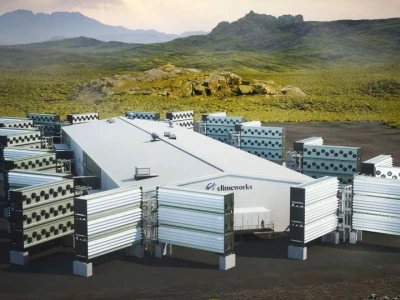
Anastasia Volkova interview: To cool the planet, ‘regenerative agriculture has to come as standard’
Numerous large food and agriculture companies have partnered with Regrow to develop tailored data platforms to advance regenerative practices in their supply.
August 8 - In a ruthlessly competitive food and agriculture industry, climate-positive agriculture appears to be one of the few areas where food giants’ brands such as PepsiCo, General Mills, Kellanova (previously Kellogg Company) and Cargill find common ground.
All are working closely with a small ag-tech firm based in a quiet rural setting outside the New Hampshire town of Durham. Regrow is one of the hottest startups in regenerative agriculture at present, recently singled out as one of TIME magazine’s Top 100 Influential Companies and the beneficiary of a successful $38 million funding round in 2022.
Why the fuss? Mostly because while large food and ag companies know that regenerative agriculture is crucial to their commercial future and our collective food security, few if any really know where to start. Much of the problem comes down to poor data, insists Anastasia Volkova, Regrow’s co-founder and CEO. “The agriculture industry has been using flat default data that has not changed for 30 years, with one number for one crop in the entire country.”
Correcting this blind spot is what led Ukrainian-born Volkova and fellow founder (and now chief strategy officer), William Salas, back in 2016 to start developing a software-as-a-service platform to calculate the carbon footprint of food companies’ agricultural supply chains.
What emerged is today known as the Sustainability Insights platform, which leverages satellite data, machine learning and soil modelling to quantify on-farm emission baselines at the field level. In addition, the resource generates scenarios to help companies determine the best crops, regions and interventions to deliver on their sustainability goals. Over time, Regrow has expanded its offering to include a Crop Insights platform and a measurement, reporting and verification (MRV) platform.
The fast pace of Regrow’s growth reflects the growing interest in regenerative agriculture among food and agriculture companies. In addition to atmospheric carbon dioxide, Regrow’s system calculates emissions rates for other potent greenhouse gases that are prevalent in modern agriculture.
These include soil organic carbon, methane emissions from livestock, and nitrogen oxides, emitted through farmers’ use of synthetic fertilisers, which the Biden administration announced last month it would focus on as it enters a new phase of its strategy to tackle climate change. Regrow’s calculations incorporate yield volumes, reductions in water consumption and other ancillary benefits from climate-smart farming. Its scope has expanded from grain production in the United States to include most of the principally traded commodities in multiple markets – including Europe, Canada, Brazil and Australia, among others.
Volkova, who holds a PhD in aerospace engineering and was recently named a “Global Visionary” by Swiss bank UBS, admits that the system’s calculations are “not perfect”, despite an inordinate number-crunching ability, courtesy of Google Cloud and Google Earth Engine.
Achieving 100% accuracy would require the system to manage a cost-prohibitive level of data, augmented by field-by-field agronomic studies, which for global multinationals sourcing from thousands of suppliers is a tall order.
“If you're buying a commodity that's been aggregated for you, you're buying it in mass,” she says. “You can't hope to trace that back to the individual farmers, but you can get a sense through this aggregation system of broadly what areas it's come from.”
Nevertheless, Regrow’s data is more than “sufficient” for public reporting requirements, she says. Its methodology for assessing the impacts of regenerative farming projects on a geographic basis (rather than project by project) also recently gained approval from the carbon offset registry, Climate Action Reserve. In fact, Regrow is one of the few data providers in North America whose numbers meet the Intergovernmental Panel on Climate Change’s Tier 3-level.
Numerous large food and agriculture companies have partnered with Regrow to develop tailored data platforms to advance regenerative practices in their supply chains.
Kellanova is a case in point. As part of its $2 billion, five-year InGrained initiative, the producer of Rice Krispies, engaged Regrow to help it reduce methane emissions linked to rice production in its North American supply chain. It’s no small challenge. A staple crop for more than three billion people around the world, rice is responsible for around a tenth of global methane emissions.
The partnership saw Kellanova develop a dual-function web platform. On the one hand, the resource gives rice producers tools, such as satellite and hyper-spectral imagery, and the information required to plan and implement a more climate-smart approach to farming. On the other, it deploys Regrow’s proprietary remote sensing technology and environmental modelling to allow Kellanova to track adoption rates by farmers and the consequent reduction in greenhouse gas (GHG) emissions. In 2022, the project’s first year, these clocked in at modest 1,600 metric tonnes.
As well as accelerating uptake among Kellanova’s own direct suppliers, the company’s chairman and CEO Steve Cahillane believes the solution has the potential to create a methodology and platform standard for reduced-methane rice and a tool for building resilience across the supply chain. For Volkova, achieving that kind of scale is key. Accurate measurement isn’t just about companies proving they are on track with their targets, she explains; it also incentivises farmers to get on board. Armed with hard data about the sustainability impacts of their regenerative practices, they can negotiate cheaper access to loan finance or, more commonly, request a premium for their products.
Usually, the premium accords with the internal carbon price adopted by food and agriculture companies, Volkova explains, with producers set to pocket anywhere from $15 to $60 per tonne or more through corporate insetting programmes. They can also potentially sell credits on carbon markets.
In addition, agricultural regeneration projects are often “stacked with government benefits”, Volkova says. For now, these are typically evaluated on a per-acre basis, rather than a per-tonne rate, giving farmers additional incentive to get involved. “If you just think about it, a tonne is a tonne, but the land is not made equal. So, for farmers in Vietnam on the rice paddy, it is a very different scale and a very different percentage of their income to what it is for a farmer in Europe or the U.S.” To secure a future for regenerative agriculture, Volkova would like to see subsidies for conventional agriculture re-routed towards a more pro-nature, pro-climate approach to farming.
She is encouraged by early moves towards a carbon tax on food and agriculture, something that most industry pundits thought was politically unfeasible. Such talk is mainly in Europe, where Denmark in June unveiled a plan to tax livestock farmers for methane emissions. In Canada, which introduced an incremental carbon tax across its economy earlier this year, hitting the agricultural sector hard, farmers have been paid a tax credit to help compensate.
To move the dial on regenerative agriculture, Volkova is anxious to see the focus moving away from crop-specific initiatives to an approach that rewards all producers in a designated landscape. This would require the market to start pricing the additional ecosystem benefits that catchment-wide land management brings – something Volkova says it manifestly fails to do at present. Assuming those benefits can be robustly measured, a tradable biodiversity credit system for nature-based solutions could be one viable solution.
She points to the “LENs” (Landscape Enterprise Networks) model, developed by UK sustainability adviser, 3Keel. This sees multiple companies come together to act as a “demand generator”, providing farmers in a specific ecosystem with the tools, knowledge and (all importantly) price guarantees to adopt regenerative practices. “In the commodity environment, we must remember that the future of regenerative (farming) is all acres globally,” Volkova states. It can’t be like organic farming, which is crop- and location-specific, and thus a premium niche.
“For us to cool the planet and leverage the soil for the carbon sequestration,” she says “This has to be the new norm for all farming.”




